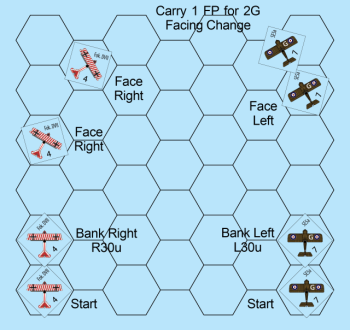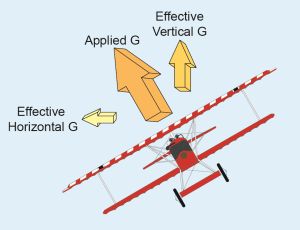The movement system in WarBirds uses a combination of horizontal and vertical flight points to move the counter on the map. An aircraft with a nose arc of 0 will have all flight points represented as horizontal, each flight point moves the counter one hex. However, when the aircraft is climbing or diving the amount of horizontal flight points will be less than the total number of flight points available. The aircraft is moving along the long side or hypotenuse of a triangle. The base leg is equal to the horizontal flight points and the vertical leg is equal to the vertical flight points. This relationship is illustrated below.
For example, the SE 5A in the figure above has a Nose Arc of 30C with a total 5 flight points available. The Py-Table is used to determine the number of horizontal and vertical flight points for the given nose arc. The aircraft will move along the long leg of the triangle . Using the WWI Py-Table, the player decides to gain 250 feet and will have four horizontal and one vertical flight points to be used during the game turn. As can be seen in the figure above, the vertical flight point does not move the aircraft forward one hex, but allows it to retain the maneuver potential of five flight points while moving a total of four hexes on the map.
Changing the counters heading or facing is accomplished by meeting a turn requirement. This requirement is based on the aircraft speed and G-Load it may pull. In the example below both aircraft must bank prior to turning (or facing). The number of hexes moved is determined by using the Turn Requirement Table. Horizontal and vertical flight points may be used to meet this requirement.
The number of nose arcs that may be changed is also dependent on the G-Load the aircraft may pull. Pulling G will incur drag and slow the aircraft. How much energy is lost depends on a number of factors and is shown on the ADC.
Depending on the players desire for detail, advanced and optional rules may be added to increase the realism of the game. For example, the applied G is broken into the horizontal and vertical components. Bank is represented in 30 degree increments. An aircraft's angle of bank determines the vertical and horizontal lift component, or G load. The greater the horizontal component, the tighter the aircraft will turn. As the bank angle increases from 0 degrees wings level to 90 degrees wings vertical, more horizontal G is available and the aircraft will turn with a tighter radius. The opposite is true for the vertical component that is used to change the nose arc, the maximum amount of vertical G is available when the aircraft's bank is 0 degrees wings level and decreases as the bank moves from 0 to 90 degrees.
The amount of realism is limited only by the player with the use of basic, advanced and optional rules. This information should give you a taste of what is inside the game files and the level of detail in the rules.



